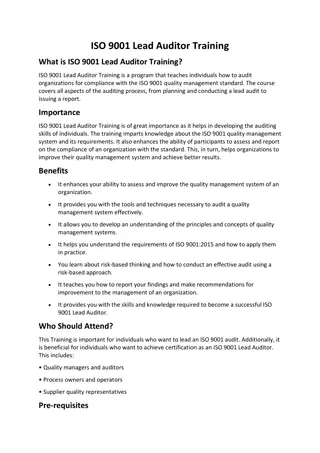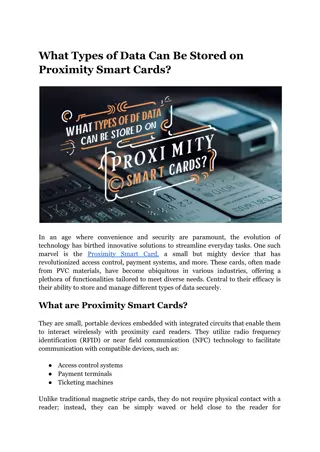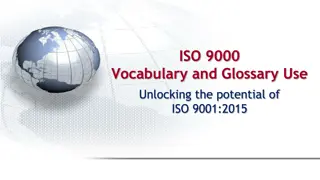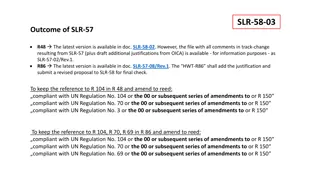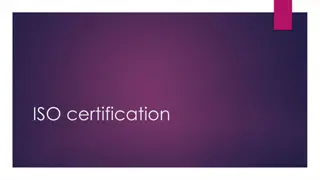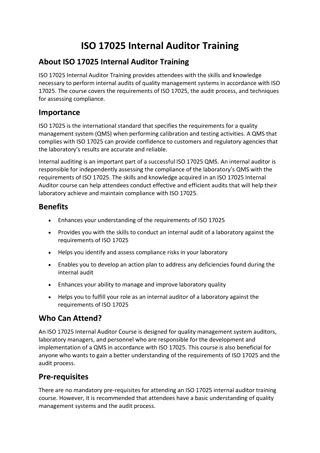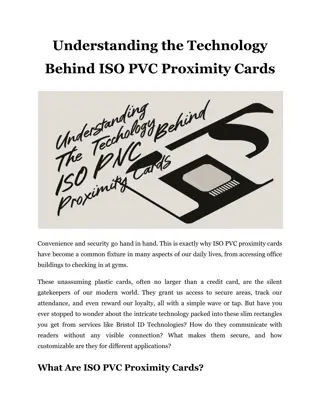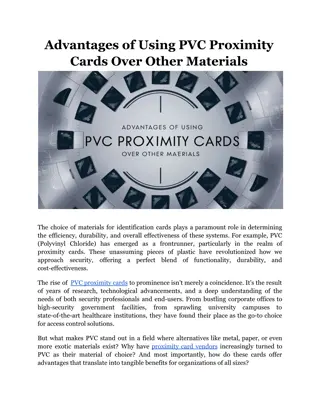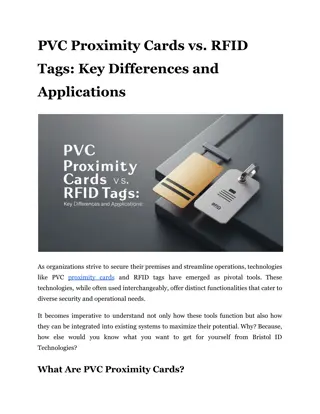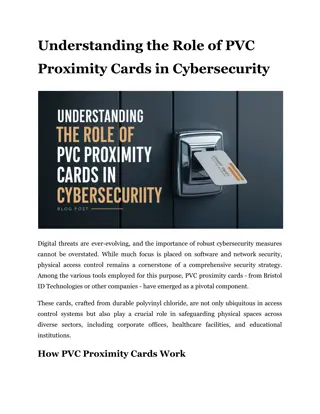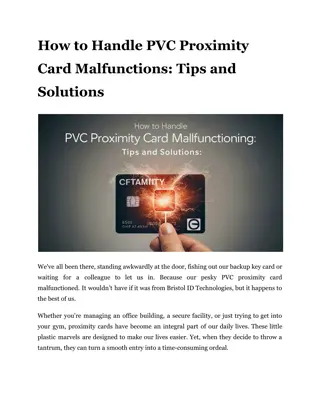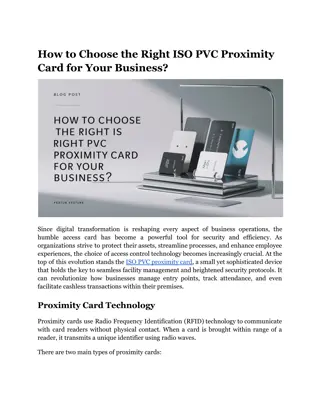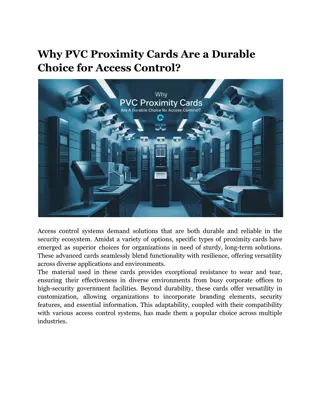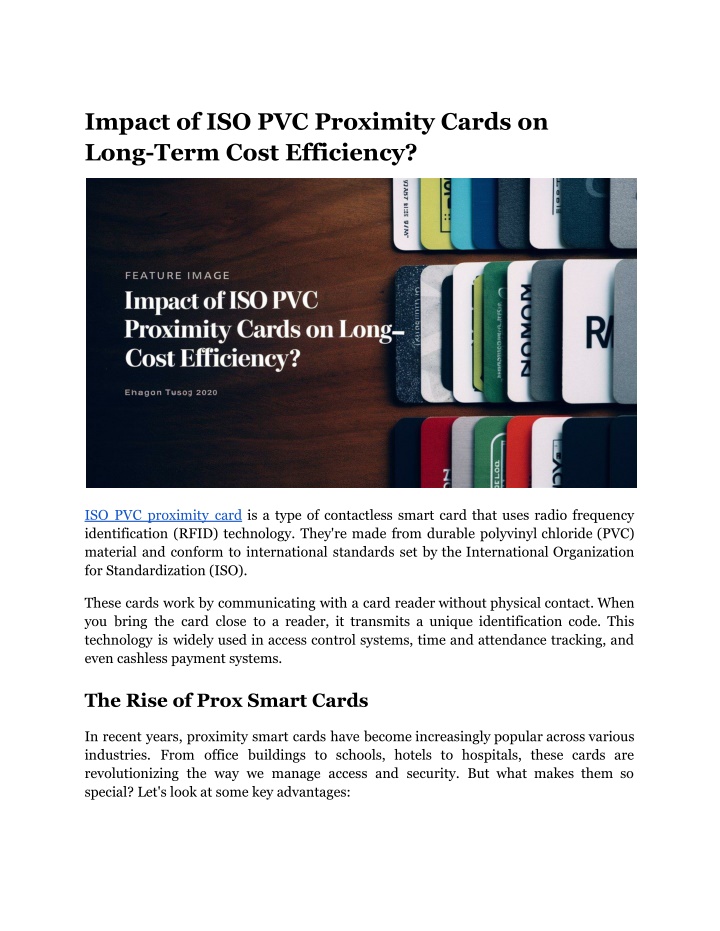
Impact of ISO PVC Proximity Cards on Long-Term Cost Efficiency
Discover how ISO PVC proximity cards can boost long-term cost efficiency for your business while enhancing security and access control.n
Download Presentation

Please find below an Image/Link to download the presentation.
The content on the website is provided AS IS for your information and personal use only. It may not be sold, licensed, or shared on other websites without obtaining consent from the author. If you encounter any issues during the download, it is possible that the publisher has removed the file from their server.
You are allowed to download the files provided on this website for personal or commercial use, subject to the condition that they are used lawfully. All files are the property of their respective owners.
The content on the website is provided AS IS for your information and personal use only. It may not be sold, licensed, or shared on other websites without obtaining consent from the author.
E N D
Presentation Transcript
Impact of ISO PVC Proximity Cards on Long-Term Cost Efficiency? ISO PVC proximity card is a type of contactless smart card that uses radio frequency identification (RFID) technology. They're made from durable polyvinyl chloride (PVC) material and conform to international standards set by the International Organization for Standardization (ISO). These cards work by communicating with a card reader without physical contact. When you bring the card close to a reader, it transmits a unique identification code. This technology is widely used in access control systems, time and attendance tracking, and even cashless payment systems. The Rise of Prox Smart Cards In recent years, proximity smart cards have become increasingly popular across various industries. From office buildings to schools, hotels to hospitals, these cards are revolutionizing the way we manage access and security. But what makes them so special? Let's look at some key advantages:
1. Enhanced Security: Proximity ID cards are much harder to duplicate than traditional magnetic stripe cards, reducing the risk of unauthorized access. 2. Convenience: Users don't need to swipe or insert the card, making the process quick and effortless. 3. Durability: The lack of physical contact with readers means less wear and tear on both the cards and the readers. 4. Versatility: These cards can be used for multiple purposes, from door access to cafeteria payments. Now that we understand the basics, let's explore how these cards can impact your organization's bottom line over the long term. Read More Articles: How to Integrate HID Prox Cards into Your Existing Security System Long-Term Cost Efficiency When considering the adoption of any new technology, it's crucial to look beyond the initial investment and consider the long-term financial impact. ISO PVC prox cards might seem more expensive at first glance compared to traditional options, but their benefits can lead to significant cost savings over time. 1. Reduced Replacement Costs One of the most immediate ways that proximity ID cards contribute to cost efficiency is through their durability. Unlike magnetic stripe cards that can easily become demagnetized or worn out, proximity cards have no moving parts and don't require physical contact with readers. This means they last much longer, reducing the frequency and cost of card replacements. Let's break it down with some numbers: Card Type Average Lifespan Replacement Frequency years) Replacement Cost card) Total Cost (100 employees, years) (5 (per 5 Magnetic Stripe 1-2 years 3-5 times $2-$5 $600-$2,500 Proximity Card 5-10 years 0-1 times $3-$8 $300-$800
As you can see, even with a higher per-card cost, the longevity of proximity cards can lead to significant savings over time. 2. Improved Operational Efficiency Time is money, and smart cards can save you plenty of both. The contactless nature of these cards means faster access times, reducing queues and bottlenecks at entry points. This improved flow can lead to increased productivity, especially in large organizations where even small time savings can add up to substantial amounts over a year. Moreover, the versatility of proximity cards means you can integrate multiple functions into a single card. Instead of managing separate systems for door access, time tracking, and cafeteria payments, you can streamline everything with one card. This consolidation can lead to reduced administrative overhead and simplified management processes. 3. Enhanced Security and Reduced Losses Security breaches can be incredibly costly, both in terms of direct losses and damage to reputation. The 125kHz proximity card technology offers a significant upgrade in security compared to traditional access methods. These cards are much harder to clone or forge, reducing the risk of unauthorized access and potential theft or data breaches. While it's difficult to put an exact number on the cost savings from improved security, consider this: according to some estimates, the average cost of a data breach in 2021 was $4.24 million. By investing in more secure access control systems, you're not just saving on potential losses; you're protecting your organization's future. 4. Energy Savings Here's an often-overlooked benefit: proximity cards can contribute to energy savings. How? Many modern access control systems can be integrated with building management systems. When an employee enters a room using their proximity ID card, it can trigger lights and climate control systems to activate. When they leave, these systems can be automatically turned off. Over time, these energy savings can add up to significant cost reductions. 5. Scalability and Future-Proofing As your organization grows, your access control needs may change. The flexibility of prox smart card systems makes it easier and more cost-effective to scale up or modify your setup. Whether you're adding new doors, integrating new functions, or expanding
to new locations, a proximity card system can adapt more easily than traditional systems. Moreover, many proximity card systems are designed with future upgrades in mind. This means you can start with a basic 125kHz proximity card system and upgrade to more advanced technologies like contactless smart cards or even mobile credentials in the future, without having to overhaul your entire infrastructure. Read More Articles: How HID Prox Cards Enhance Security in Access Control Systems Choosing the Right Proximity Card System To maximize the cost efficiency of your proximity card system, it's crucial to choose the right solution for your needs. Here are some factors to consider: 1. Card cost-effective, you might also consider higher frequency options like 13.56MHz cards for additional security and functionality. 2. Reader Compatibility: Ensure the readers you choose are compatible with your chosen card technology and can integrate with your existing systems. 3. Scalability: Look for systems that can grow with your organization and accommodate future technological advancements. 4. Support and Maintenance: Consider the long-term costs of system support and maintenance when making your decision. 5. Additional Features: Some proximity smart card systems offer advanced features like encryption or biometric integration. Evaluate whether these features are worth the additional cost for your organization. Technology: While 125kHz proximity cards are popular and Conclusion In today's competitive business environment, every dollar counts. While the upfront cost of implementing an ISO PVC prox card system might seem daunting, the long-term benefits in terms of security, efficiency, and cost savings can be substantial. From reduced replacement costs to improved operational efficiency, enhanced security, and energy savings, proximity ID cards offer a range of advantages that can positively impact your organization's bottom line. Bristol ID Technologies delivers the best HID Prox Cards in the industry. Our proximity cards offer unbeatable quality and security for your access control needs. Choose us for reliable HID ProxCard solutions that protect your organization.
FAQs What is an ISO PVC proximity card? An ISO PVC proximity card is a contactless smart card that uses RFID technology for identification and access control. It's made of durable polyvinyl chloride (PVC) and conforms to international standards. How do proximity cards contribute to long-term cost efficiency? Proximity cards contribute to cost efficiency through reduced replacement costs, improved operational efficiency, enhanced security, energy savings, and scalability for future needs. Are proximity cards more secure than traditional magnetic stripe cards? Yes, proximity cards are generally more secure as they are harder to duplicate or forge compared to traditional magnetic stripe cards, reducing the risk of unauthorized access. Can proximity cards be used for multiple purposes? Yes, proximity cards are versatile and can be used for various purposes including door access, time and attendance tracking, and even cashless payment systems within an organization. What should I consider when choosing a proximity card system? When choosing a proximity card system, consider factors such as card technology, reader compatibility, scalability, support and maintenance costs, and any additional features that might benefit your organization. Site Article: Impact of ISO PVC Proximity Cards on Long-Term Cost Efficiency?



